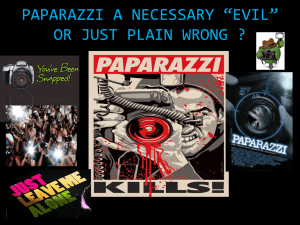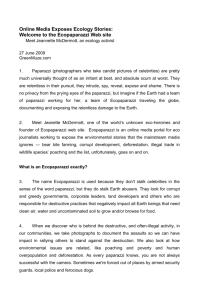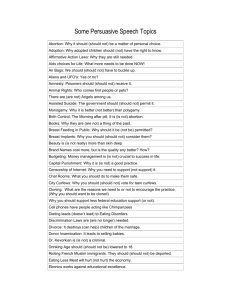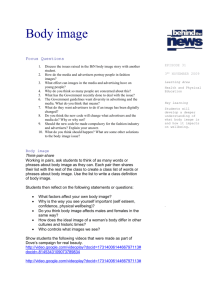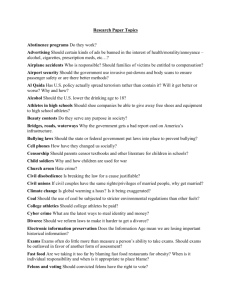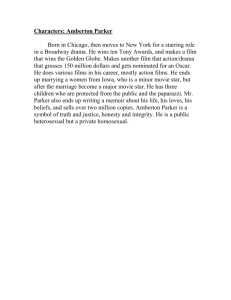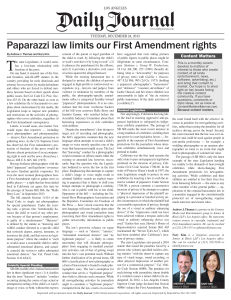Paparazzi, the Plight of Celebrities and their Children
advertisement
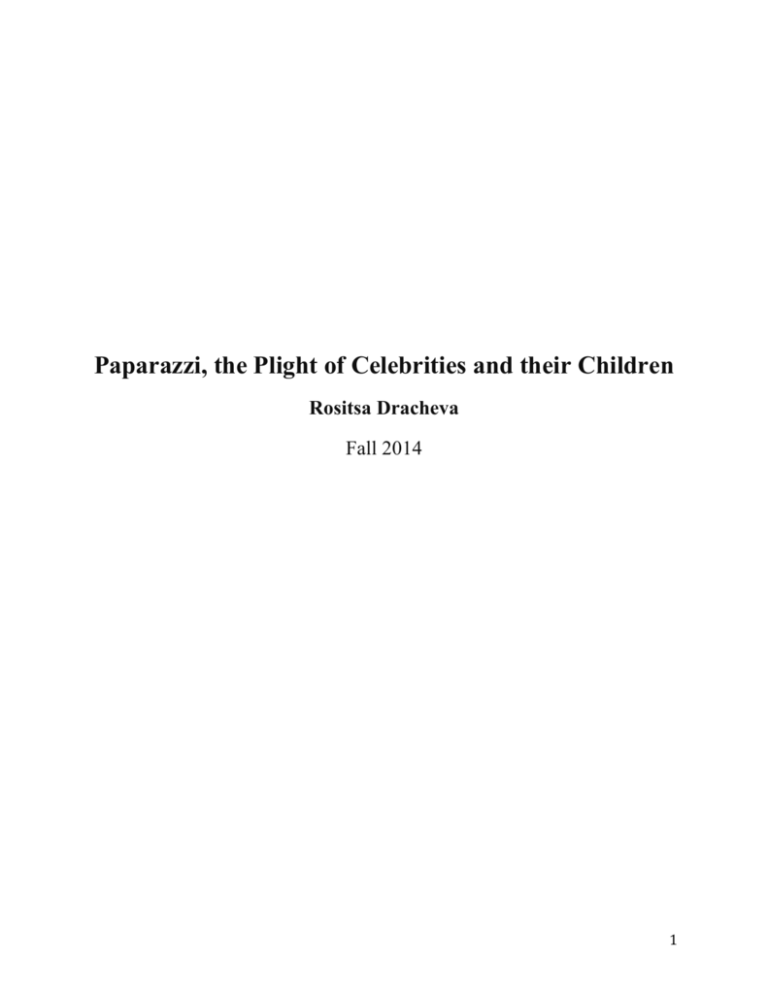
Paparazzi, the Plight of Celebrities and their Children Rositsa Dracheva Fall 2014 1 For centuries, people have been fascinated with the lives of others. A person’s curiosity is heightened, especially when it comes to famous successful people. With the help of the media or more specifically, the paparazzi, society gets immersed in to the lives of celebrities by wanting to know their every move, and thus, feeding the paparazzi frenzy of dangerous behavior. For example, going back to 1973 and the tenacious stalking by a paparazzo of former first lady Jacqueline Kennedy Onassis and her children1, moving to the car chase by paparazzi that caused the death of Princess Diana and her boyfriend2, ending in today’s world of car chases which cause accidents3, bullying of children4 and hurting innocent by standers5, all while trying to get a photograph. The most current trend is society’s obsession with the children of celebrities, hence breathing fire into the dangerous conduct of the paparazzi. Famous or not, however, children should not be subject to the harassing conduct of paparazzi just because the paparazzi want to take a photograph. Consequently, since the paparazzi are allowed to take pictures of children in public places, the law should require the paparazzi to maintain a certain distance and not speak to children, so as to not cause them physical and emotional trauma. Further, despite the fact that celebrities are public figures who are afforded less privacy, especially in public places, they should not have to endure the behavior of the paparazzi which results in intentional infliction of 1 Galella v. Onassis, 487 F.2d 986, 992 (2d Cir. 1973). Note: Taming the paparazzi in the “Wild West”: A look at California’s 2009 Amendment to the Anti-Paparazzi Act and a call for increased privacy protection for celebrity children, 84 S. Cal. L. Rev. 201, 207 3 Samantha J. Katze, Hunting the Hunters: Ab 381 and California's Attempt to Restrain the Paparazzi, 16 Fordham Intell. Prop. Media & Ent. L.J. 1349, 1352 (2006) 4 Suri Cruise verbally attacked by paparazzi!, YouTube (Jul. 13, 2013) https://www.youtube.com/watch?v=XNPreZLIzFg 5 Hunting the Hunters…, 16 Fordham Intell. Prop. Media & Ent. L.J. 1349, 1352 (2006) 2 2 emotional distress, harassment, assault and battery, particularly when the children of the celebrities are involved and subject to the same offenses. This paper begins by examining the dangerous conduct of the paparazzi towards the children of celebrities, through the lens of the old but very famous case Galella v Onassis.6 Next, it will examine and assess the California Anti-Paparazzi Statute’s amendments over recent years as well as the recent amendment to California Penal Code. Finally, this paper will conclude by proposing a solution that calls for a paparazzi-free zone for children, so that they are shielded from the harassing conduct of the paparazzi. I. Galella v Onassis Galella v Onassis is the best-known case, involving Donald Galella, the original paparazzo7, who tenaciously stalked former first lady Jacqueline Kennedy Onassis and her children. Donald Galella was a free-lance photographer (paparazzo) who immersed himself into the lives of Mrs. Onassis and her children, by following their every move and endangering their lives.8 The irony of the case, however, is that the suit was filed by Mr. Galella against Mrs. Onassis and her secret service agents for false arrest, malicious prosecution and interference with trade.9 Mrs. Onassis then filed a counter claim for harassment, intentional infliction of emotional distress, assault, battery, and invasion of privacy.10 After a six-week trial, the claims against the secret service 6 Galella v. Onassis, 487 F.2d 986 (2d Cir. 1973). Galella, 487 F.2d 986 at 992 (A paparazzo as the court defined it is ‘(literally a kind of annoying insect, perhaps roughly equivalent to the English ‘gadfly.’) Paparazzi make themselves as visible to the public and obnoxious to their photographic subjects as possible to aid in the advertisement and wide sale of their works.’) 8 Id. at 991 9 Id. at 992 (“Galella took pictures of John Kennedy riding his bicycle in Central Park across the way from his home. He jumped out into the boy's path, causing the agents concern for John's safety. The agents' reaction and interrogation of Galella led to Galella's arrest and his action against the agents…”) 10 Galella v. Onassis, 353 F Supp. 196, 199 (S.D.N.Y. 1972) 7 3 agents and Mrs. Onassis were dismissed and she was granted injunctive relief.11 The court enjoined Mr. Galella From: “1) keeping the defendant and her children under surveillance or following any of them; 2) approaching within 100 yards of the home of defendant or her children, or within 100 yards of either child’s school or within 75 yards of either child or 50 yards of defendant’ 3) using the name, portrait or picture of defendant or her children for advertising; 4) attempting to communicate with defendant or her children except through her attorney.”12 Galella appealed the district court’s judgment.13 The United States Court of Appeals for the Second Circuit affirmed the trial court’s decision in dismissing the claim of Mr. Galella and agreeing that the secret service agents where immune from liability because they were performing their job.14 Further, the Second Circuit affirmed but modified the cost order and injunctive relief as it found it overbroad.15 Nevertheless, the Second Circuit held that evidence showed that Mr. Galella harassed Mrs. Onassis and her children and was liable for harassment, assault, intentional infliction of emotional distress, battery and invasion of privacy.16 The injunctive relief approved by the trial court was more appropriate than the modification made by the appeals court. The appeals court made a mistake by modifying the remedies, specifically, the injunctive relief. Thus, Judge Timbers correctly stated in his dissenting/concurring opinion that the trial court should have not modified the injunctive relief.17 The modification of the distance restriction made by the district court did not afford the protection necessary to shield the children from the harassing behavior of Galella, and the 11 Galella, 487 F.2d 986 at 992 Id. at 993 13 Id. at 993 14 Id. at 998 15 Id. at 998 16 Id. at 998 17 Id. 12 4 restriction would not be enough to protect any other children from the paparazzi.18 At 30 feet away a paparazzo, in this case Galella, could still endanger the lives of the children, and cause them physical and emotional pain.19 Today, the issue is even worse as there is not just one paparazzo screaming, yelling and jumping; there are many of them, upwards of a dozen. As witnessed by a celebrity bodyguard: “‘It's getting crazier,’ Lee Weaver, a former bodyguard for Lindsay Lohan, told ABCNews.com.A bodyguard for 20 years, Weaver has seen the number of paparazzi proliferate. Back when he was protecting Kim Basinger, he recalled accompanying her and then-husband Alec Baldwin to their home after the birth of their daughter Ireland in 1995.’Kim was holding the baby, and this photographer just jumped out of the bushes,’ Weaver remembered. ‘Kim almost dropped the baby. We rushed her in the house. Then me and Alec had to respond. We sure didn't invite him for dinner.’ The difference today? ‘It would have been four or five in the bushes,’ he said.” 20 Paparazzi hiding in the bushes should not be the first concern of mother when bringing a newborn baby home from the hospital. Unfortunately instead of a joyful and peaceful moment, celebrity mothers as well as fathers have to worry about the paparazzi.21 The paparazzi, as seen from the quoted bodyguard above, are not concerned about the safety of celebrities or their children they just want the picture. 22 Moreover, today, celebrity parents are dealing with a worse situation as the amount of paparazzi fighting for that famous picture has increased dramatically. 23 A. The Trial Court Got it Right 18 Id. at 1001 Id. at 1000 20 Luchina Fisher, Hired Guns: Armed Guards Latest Celeb Accessory, (Jul. 29, 2008), http://abcnews.go.com/Entertainment/story?id=5471050&page=1 21 Simon Cowell Leaves Hospital with Newborn Baby Son!, YouTube, (Feb. 18, 2014), https://www.youtube.com/watch?v=6447N_kzdSM 22 Hired Guns: Armed Guards Latest Celeb Accessory, (Jul. 29, 2008), http://abcnews.go.com/Entertainment/story?id=5471050&page=1 23 Simon Cowell Leaves Hospital with Newborn Baby Son!, YouTube, (Feb. 18, 2014), https://www.youtube.com/watch?v=6447N_kzdSM 19 5 According to the district court, Galella’s conduct was not immunized by the First Amendment, “...because there was no general constitutional right to assault, harass, or unceasingly shadow or distress public figures.”24 Galella continuously tormented Mrs. Onassis and especially her children and was subjecting them to situations involving their physical safety25. Indeed, public figures inadvertently, “agree”, and are subject to some form of invasion of their private life, especially when they are in public. While, Mrs. Onassis is a public figure and most of the conduct happened on public property, she and more specifically her children, should not be subject to the agonizing following by Galella. Moreover, no public or private figure should be exposed to harassment, assault, battery, and intentional infliction of emotional distress, particularly, when children are involved. 1. Invasion of Privacy Celebrities have an action for privacy, though not in public places, under the Second Restatement of Torts26. Four types of privacy torts exist: 1) intrusion upon seclusion, 2) appropriation of name or likeness, 3) publicity of private facts, and 4) false light. 27 As this paper focuses more on protection of celebrities and their children from the conduct of the paparazzi, while taking the photograph and no the actual snapping of the photograph, the paper briefly defines these torts but does not examine them in detail. First, “[o]ne commits intrusion upon seclusion when one intentionally intrudes, physically or otherwise, upon the solitude or seclusion of another or his private affairs or concerns, if the intrusion would be highly offensive to a reasonable person”.28 Second, “[o]ne 24 Galella v. Onassis, 353 F Supp.at 199 Id. 26 Restatement (Second) of Torts §652 (1997) 27 Id. 28 Id. at §652B 25 6 commits appropriation of name or likeness when one appropriates to his own use or benefit the name or likeness of another.” 29 Third, Public or Private Facts – “ One who gives publicity to a matter concerning the private life of another is subject to liability to the other for invasion of his privacy, if the matter publicized is of a kind that: (a) would be highly offensive to a reasonable person and (b) is not of legitimate concern to the public.” 30 Fourth, False Light is committed when: “One who gives publicity to a matter concerning another that places the other before the public in a false light is subject to liability to the other for invasion of his privacy, if (a) the false light in which the other was placed would be highly offensive to a reasonable person, and (b) the actor had knowledge of or acted in a reckless disregard as to the falsity of the publicized matter and the false light in which the other would be placed.”31 Although, the court in Galella concluded Galella’s conduct to constitute tortious invasion of privacy, today, it would be very hard for the celebrities to get a favorable outcome. Even if the celebrities were able to get a ruling in their favor for invasion of privacy, the ruling would not solve the problem, as the problem is not the conduct of the actual taking of the photograph by which the privacy is invaded (clicking the button to take the picture) but the conduct beforehand (the provocative language, the proximity to the celebrities and their children, etc.). Conduct, which provokes the celebrity and their children while getting in their face, just so that a paparazzo/a can get a well-paid photograph.32 Consequently, today instead of an action 29 Id. at §652C Id. §652D 31 Id. at §652E 32 Suri Cruise verbally attacked by paparazzi!, YouTube (Jul. 13, 2013), https://www.youtube.com/watch?v=XNPreZLIzFg; Halley Berry Gets Angry With The Paparazzi at Barefoot, YouTube (May2, 2009), https://www.youtube.com/watch?v=bhQ2zkHYWo 30 7 for privacy, the better approach for the celebrity to protect their children is the cause of action of harassment, assault, intentional infliction of emotional distress, and battery. 2. Harassment The paparazzi should not be immune from liability for taking photographs of celebrities and their children while committing harassment. In Galella, the district court examined the New York Penal Law33, to determine when a person is liable for harassment.34 The code provides: "A person is guilty of harassment when, with intent to harass, annoy or alarm another person: "1. He strikes, shoves, kicks or otherwise subjects him to physical contact, or attempts or threatens to do the same; or "3. He follows a person in or about a public place or places; or "5. He engages in a course of conduct or repeatedly commits acts which alarm or seriously annoy such other person and which serve no legitimate purpose." 35 The abundance of evidence helped the court determine that it was, Galella’s, “Conscious purpose” to provoke Mrs. Onasis in any way possible, so that he can get certain facial expression, thus satisfying the intent element of harassment.36 From Mrs. Onassis’ testimony one could see the distress and anguish caused by Galella: “It caused me anguish. It caused me fear for my safety, for the safety of my children. At times it caused me terror, distress, no peace, no peace of mind, fear for what was going to happen to them and to me when we would encounter him again; also being under surveillance, [sic] imprisoned in your house, all that deportment over all this time was--caused an enormous strain and unhappiness, and all of that on me, for myself and for my children.”37 Celebrity mothers are afraid for the safety of their children every time they are out in the 33 Section 240.25 of the New York Penal Law, McKinney's Consol. Laws, c. 40 Galella, 353 F. Supp. at 226-227 35 Id. 36 Id. at 217-218 37 Id. at 217-218 34 8 public swarmed by dozens of paparazzi.38 A perfect example of this is an incident involving Kate Moss and her young daughter arriving at Los Angeles International Airport, where she was swarmed by dozens of paparazzi and which ultimately caused her to shove her way through a barricade of paparazzi while pushing her daughter on a luggage cart.39 Further “[t]he video has an almost strobe-like effect from the constant flashing of lights, as paparazzi scream at the star— a situation that would be unimaginably horrifying for a young child caught in the crossfire.”40 Additionally, to gain some sort of privacy Kate Moss crouched behind the desk of an airport security, while her daughter was taken out of the airport separately.41 To be able to get to her shuttle van she was escorted by a blockade of airport security who linked their arms and surrounded her to prevent the paparazzi from getting close to her.42 This situation plays out on daily basis with different celebrities43,the more famous the celebrities are the worse the situation.44 Thus, necessary changes (which will be discussed in section III) need to be established for the protection of children, especially in places densely populated with celebrities, such as New York and California.45 3. Assault and Battery 38 Halley Berry Gets Angry With The Paparazzi at Barefoot, YouTube (May2, 2009), https://www.youtube.com/watch?v=bhQ2zk-HYWo (Halley Berry, holding her daughter and asking the paparazzi to back up so that she can get out of a restaurant, as the paparazzi have almost block the sidewalk. Then she resorts to calling the police and having her and her daughter escorded. 39 See Note: Taming the Paparazzi… 84 S. Cal. L. Rev. at 204 40 Id. 41 Id. 42 Id. 43 Halley Berry Gets Angry With The Paparazzi at Barefoot, YouTube (May2, 2009), https://www.youtube.com/watch?v=bhQ2zk-HYWo; Suri Cruise verbally attacked by paparazzi!, YouTube (Jul. 13, 2013), https://www.youtube.com/watch?v=XNPreZLIzFg; Kourtney Kardashian tells paparazzi “Shut the f*ck up”, YouTube (Dec. 18, 2013), https://www.youtube.com/watch?v=urizBsjGgjU 44 Id. 45 See Note: Taming the Paparazzi… 84 S. Cal. L. Rev. at, 302 9 Commonly the tort of assault is when a person places another in a reasonable apprehension of a battery, for which actual or physical harm is not necessary, whereas battery is intentional harmful or offensive contact. 46Again, Galella, as the district court found and the second circuit affirmed, committed both torts. From the testimony of Mrs. Onassis, her children and even the secret service agents it is evident that Mrs. Onassis and her children suffered assault and battery: “At other points in her testimony she used such expressions as ‘terrified’ ‘frightened’ ‘stunned’ ‘startled’ ‘afraid’ ‘anguished’ ‘humiliated’ John Kennedy: I feel threatened when he is present. I very much wish to avoid him. I think anyone would fear someone who follows you everywhere. Caroline Kennedy: Unfortunately, I am one of his favorite targets ... have been subjected to numerous unpleasant and often dangerous incidents with him . . . I don't feel safe when he is near and will go to great lengths to avoid him. He never lets me alone. He scares me. Agent Kalafatis: I have seen John and Caroline on several occasions freeze up when they see him ... it really bothers them seeing this man all the time following them wherever they go . . . Agent Connelly: . . . Galella's activities--such as his rushing up to the and his taking flash photographs of them from close range--have endangered the physical and mental well-being of the Kennedy children. Agent Ambrose: . . . I feel that his presence near the principals contributes to their feeling abnormally self-conscious.”47 Intent is an element of both, the tort of assault as well as the tort of battery. In this case specifically, the court did not have a problem concluding that the intent element was satisfied for both torts.48 After all it was Galella’s conscious objective to provoke Mrs. Onassis as to produce a facial expression different from her normal one, while disregarding her and her children’s physical safety.49 For example, Galella was provoking and at the same time intimidating Mrs. 46 Galella v. Onassis, 353 F. Supp. at 226 Id. at 217-218 48 Id. at 216-217 49 Id. (“At times the threat of physical harm was heightened, as it appeared that the propeller of his boat might cut defendant's legs or that his wash might capsize John's boat or that John would 47 10 Onasis and Caroline with his offensive mountings.50 Specifically, those offensive mountings including: "grunts", "yells", makes "strange sounds", "laughs" and calls to defendant: "How do you like me?"; "The Marines have landed!"; "Ha Ha", "Snuggle up to Santa"; "Glad to see me back, aren't you, Jackie?" And to Caroline: "I am not making you nervous, am I, honey?" (he was making her cry); "How do you like the great paparazzi being s back again!"51 Like Galella, today’s paparazzi have the conscious objective in provoking the celebrities and their children, so that they can get the million-dollar photograph.52 Suri Cruise, a seven-year old girl, hiding her face, clutching to her mom is a perfect example of how scared the little girl is by the flock of unknown man, the paparazzi, being so close to her and trying to provoke her.53 Through countless videos shown on the news and other entertainment channels as well as the Internet, it is evident that today the paparazzi do the same things, but in much more aggressive fashion.54 A perfect example of that behavior is the video involving Kim Kardashian and her sister Kourtney (who is holding her child).55 For example, the video evidences the large number of paparazzi, who made it hard for Kourtney (while still holding her child) and Kim to move.56 Further, the paparazzi yelled insulting remarks about the family to try and get a reaction for a well-paid photograph.57 Moreover, Kourtney, tried to protect her child and in her frustration fall from his bicycle or his horse. At other times there were deliberate or predictable contacts or physical consequences--the ‘flicking’ of his camera strap, ‘pushing’, ‘brushing’, after-images of endless flashbulbs, John falling to his knees at night or Caroline falling off her water skis.”) 50 Id. at 217 51 Id. 52 Suri Cruise Yells At Papaprazzi While With Mom Katie Holmes In NYC, YouTube (Mar. 21, 2012), https://www.youtube.com/watch?v=FuRl1TwvRgA 53 Id. 54 Kourtney Kardashian tells paparazzi “Shut the f*ck up”, YouTube (Dec. 18, 2013), https://www.youtube.com/watch?v=urizBsjGgjU 55 Id. 56 Id. 57 Id. 11 with the photographers, yelled at paparazzi asked to be left alone and for them to “shut the f*ck up -- don't talk to me ever when I'm with my kids.”, which resulted in the child crying.58 In the above video Kourntey only yelled at the paparazzi to try to protect her child. However, there are encounters in which the harassed celebrity goes to the extent of committing both torts of assault and battery against the paparazzi, by punching, shoving, smashing cameras, so as to protect themselves and their children.59 Evidently, Mrs. Onassis and her children had it bad; however, the celebrities and their children these days have it even worse as the paparazzi get literally in the face of the particular celebrity.60 Galella was the only paparazzo tormenting Mrs. Onassi, today at least a dozen torment a particular celebrity on a daily basis, as seen on the video where Kim Kardashian is pushing her baby in a stroller and she is swarmed by paparazzi barely able to move.61 3. Intentional Infliction of Emotional Distress. Although, a famous person gives up the right to privacy due to their profession, they do not give up the right to be able to take a walk with their children, go to the park or the doctor’s office free of physical danger and emotional distress. The common law tort of intentional infliction of emotional distress requires intent to cause another emotional distress. New York, however, recognizes freedom from mental disturbance62. Specifically, the only proof needed to 58 Id. Loosing It: When Celebrities Attack, YouTube (Jun 23, 2012), https://www.youtube.com/watch?v=9i8N5bLgljY 60 Id. 61 Galella v. Onassis, 353 F. Supp. at 226 (“Galella profited by being the only American paparazzo. He had the field to himself; no one else was willing to harass, torment and victimize a subject. He alone was unchecked by inner prohibitions. He alone believes in his right to harass defendant. At trial, when we asked plaintiff's counsel whether a public figure must submit to harassment, there was no response.”); Kim Kardashian Pushes Baby North Into Swarm of Paparazzi, YouTube (Dec. 17, 2013), https://www.youtube.com/watch?v=DhP_OeyK9rM 62 Galella v. Onassis, 353 F. Supp. at 230 59 12 recover for intentional infliction of emotional distress is the duty to refrain from inflicting it.63 Further, “All that is required in the way of intent is that emotional distress be reasonably foreseeable to the actor. As the court held in Mitran v. Williamson64: "Actual intent to cause emotional disturbance is not necessary since the willful wrongdoer may be charged with the duty of foreseeing the mental and emotional consequences that would naturally flow from his conduct. . . "65 Furthermore, the court in Nader v. General Motors Corp.,66 stated: "[Where] severe mental pain and anguish is inflicted through a deliberate and malicious campaign of harassment or intimidation, a remedy is available in the form of an action for the intentional infliction of emotional distress." 67 Additionally, in Flemm v Van Nierop68 the court held: "If a man finds himself perpetually haunted by an enemy; if he is greeted at every turn by baleful looks, sudden sorties which fall short of physical contact, and derisive laughter; if he cannot drive his car without the imminent threat of a collision from the rear; and if he is troubled at all hours by telephone calls followed only by silence, then it can hardly be doubted that he is being subjected to the extreme and outrageous conduct which gives rise to a cause of action in tort."69 It could be deduced from Galella’s behavior that his conduct was extreme and intentional. Though intent is not necessary, under New York law, to prove that Mrs. Onassis and her children suffered emotional distress, there is enough evidence in the records to prove both New York law of emotional distress, as well as the common low tort.70 Moreover, conduct such as the one 63 Halio v. Lurie, 15 A.D. 2d 62, 66, 222 N.Y.S. 2d 759, 763 Mitran v. Williamson, 21 Misc. 2d 106, 108, 197 N.Y.S. 2d 689, 691 (S. Ct. 1960) 65 Galella v. Onassis, 353 F. Supp. at 230 66 Nader v. Gen. Motors Corp., 25 N.Y.2d 560, 564, 307 N.Y.S.2d 647, 650, 255 N.E.2d 765, 767 (1970) 67 Galella v. Onassis, 353 F. Supp., at 230 68 Flamm v. Van Nierop, 56 Misc, 2d 1059, 1060, 291 N.Y.S.2d 189, 190 (Sup. Ct.1968) 69 Galella v. Onassis, 353 F. Supp., at 239 70 Id. When Galella rushed her limousine at 1040 on September 21, 1969, she was terrified. (2028) Galella's pursuit of her and the children at the horse show in Gladstone, New Jersey, caused her concern and anxiety for fear that his activities would frighten the horse and thereby endanger her children. (2046-2047) Galella's sudden appearance behind bursting flash bulbs at 2 64 13 quoted from Flemm, is also enough to prove both assault as well as battery. For example, Nichole Richie and her two young children were granted a temporary restraining order against two photographers who rear-ended her car while chasing her in Beverly hills.71 This specific incident combines violation of the torts of assault, harassment, battery and intentional infliction of emotional distress. Again, assault requires reasonable apprehension of physical contact, which is satisfied by the fact that being chased by a car causes reasonable apprehension of being hit by that car. Further, intentional infliction of emotional distress is also satisfied because the chasing paparazzi has the intent to chase the celebrity and a reasonable person knows that this causes emotional distress especially when children are in the car. Additionally, intentional and harmful contact is required for battery; the actual hitting of the car satisfies that element of the tort. While, the intent of the paparazzi might not have been to hit o'clock in the morning at Oliver Smith's house in Brooklyn Heights stunned and startled her. (2099) When Galella crashed about in the tunnel beneath Lincoln Center and tried to push his way through a revolving door with Mrs. Onassis and her children she was frightened that someone would be injured in the door. (2085) Galella's antics in the theatre at 40 Carats so upset Mrs. Onassis that she covered her face with Playbill. (2121) When Galella cruised around Mrs. Onassis in a power boat as she was swimming off Ischia, he was so close that she was afraid she would be cut by the propeller. (2210) Galella's dogging of Mrs. Onassis' footsteps throughout her shopping trip in Capri left her terrified and upset. (287, 2187a, 2203) Galella's taxicab chase with Joyce Smith on October 7, 1971 left Mrs. Onassis a "wreck." When Galella suddenly jumped from behind the wall in Central Park, frightening John and causing him to lose control of his bicycle, Mrs. Onassis described her state of mind as having been "terrorized." (243) 36 The Santa Claus pursuit in and around the Collegiate School in December 1970 left Mrs. Onassis extremely upset. (2432) Galella's outrageous pursuit of Mrs. Onassis on the night of Two Gentlemen of Verona terrified her and left her in an [219] "anguished," "humiliated" and "terribly upset" state. (2502-2503) Numerous times, and at dangerous speeds, he has followed cars in which the children were passengers, violating the rules of the road, and the Secret Service agents assigned to protect the children have frequently expressed concern for the safety of their principals as a result of Galella's activities. (4644-4645 [Keller]; 4660-4662 [Walsh]; 4216-4217A [Connelly]; 4078-4080 [Kalafatis]). 71 See Note: Taming the Paparazzi… 84 S. Cal. L. Rev. at 211 14 Nicole Richie’s car, they intended to chase her and that element of intent transfers to battery72. Moreover, the chase and the accident also put bystanders and surrounding drivers into harms way. While this injunctive relief was a step in the right direction, it was not enough to grant the relief against just those two photographers, as this situation has happened numerous times.73 The restriction should be against all paparazzi, specifically when children are involved, otherwise it would be unfeasible for celebrities to seek restraining orders against each and every paparazzo/a.74 The above is not to say that the court should grant injunctive reliefs against all paparazzi, but that the legislature should draft a law, which includes a proximity restriction. Further, the above examples and sited videos exemplify the crazy behavior of the paparazzi and the affect it has on celebrity and their children, the behavior which has prompted people to refer to, California, and specifically Los Angeles, as the “Wild West.”75 Thus, California was one of the first states to enact an anti-paparazzi statute to try to curb the untamed behavior of the paparazzi. II. The California Anti Paparazzi Statute and California Penal Code In 1998, California was the first state to pass an Anti-Paparazzi Statute76 prompted by the death of the beloved princess Diana and her boyfriend who were killed while trying to escape the 72 RESTATEMENT (THIRD) OF TORTS: Liability for Physical Harm (Basic Principles) §1 cmt. b 73 Galella v. Onassis, 353 F. Supp., 230 See Note: Taming the Paparazzi… 84 S. Cal. L. Rev. at 211 75 Id. 76 Id. at 203 ; California Civil Code §1708.8 74 15 paparazzi.77 The statute holds “…photographers liable for invasion of privacy when they trespass on private property or use and enhancing device to obtain an image or sound that otherwise could not have been obtained without trespass, with the intent to capture any type of visual image or sound recording.”78 A flaw in that statute was that it only concerned trespass; the statute did not speak of public places or the protection of children. Children are the innocent parties that suffer the most, because children, unlike adults cannot protect themselves emotionally especially from strange men such as the paparazzi. This situation was witnessed in Galella, were the children suffered greatly.79 Furthermore, it is obvious from the cited videos that the statute has not deterred the paparazzi, as their behavior has grown more obnoxious and dangerous through the years. Some of the countless examples of dangerous paparazzi conduct are the incidents in which a paparazzo Galo Ramires jammed his car into Lindsay Lohan’s Mercedes while trying to take her photograph. 80 Another incident involved Scarlett Johanson crashing into a car with a woman and her children while trying to escape the paparazzi who had followed her for over one hour. 81 Additionally, photographer Todd Wallace was cited for misdemeanor counts of assault 77 Id. at 207 (“Princess Diana’s death sparked a tremendous backlash against paparazzi worldwide. Legislatures raced to pass law in attempts to prevent another tragedy from occurring at the hands of the paparazzi. In the United States, Congress proposed several bills… Though anti paparazzi legislation failed at the federal level, California was quick to react, with Governor Peter Wilson signing the Anti Paparazzi Act in 1998.”) 78 Id. at 208, “The law will make photographers liable for invasion of privacy when an individual trespasses on private property with "the intent to capture any type of visual image, sound recording, or other physical impression of the plaintiff engaging in a personal or familial activity and the physical invasion occurs in a manner that is offensive to a reasonable person." The new legislation would also allow individuals to sue for "constructive" trespass, or trespass to obtain, by way of an electronic enhancing device of a visual or auditory nature, an image that the photographer could not have obtained otherwise without physically trespassing.” See more at: 79 Galella v. Onassis, 353 F. Supp. At 216-217 80 Hunting the Hunters… 16 Fordham Intell. Prop. Media & Ent. L.J. 1349, 1352 (2006) 81 Id. 16 and battery after he assaulted two park employees while attempting to photograph Reese Witherspoon and her two children during their visit to Disneyland. 82 Consequently, the need for change, prompted and amendment to the Anti-Paparazzi Statute and as well as the California Penal Cod. A. Anti-Paparazzi Statute’s amendments until 2010 Since the current laws were not serving their intended purpose, in 2005, prompted by the above-mentioned incidents, California Legislators enacted another amendment to §1708.8 of the Civil Code.83 Nonetheless, that amendment is just as big a failure as the preceding ones, as the behavior of the paparazzi remains unchanged.84 The Code was amended such that it extended liability to both the photographer who took the photograph in violation of the statute as well as the outlets that publish the photograph. 85 To prove a violation under the new code one must prove that the photograph was taken under the following circumstances: “1) a physical invasion of privacy, 2) a constructive invasion of privacy, or 3) an assault.”86 The first two elements will not be discussed as they involve the celebrity being on private property and that is outside the scope of this paper. Despite the fact that including assault as an element was a step in the right direction, the legislators should have gone further and eliminated the intent element of assault. Even after Galella, it will be hard for celebrities to prove assault.87 Thankfully, after the push of many 82 Id. Id. 84 Kourtney Kardashian tells paparazzi “Shut the f*ck up”, YouTube (Dec. 18, 2013), https://www.youtube.com/watch?v=urizBsjGgjU 85 See Note: Taming the Paparazzi… 84 S. Cal. L. Rev. at 215 86 Id. at 216 87 Id. 83 17 celebrities towards a protection for their children an amendment was proposed to California Penal Code.88 B. Getting Closer – California’s Penal Code Amendment Despite the many failed attempts to create a statute that protects the celebrities from the harassing behavior of paparazzi, California is finally getting closer. With the push of many celebrity mothers, such as Halle Barry and Jennifer Garner89 an amendment to California Penal Code was enacted in 2013. The aim of that amendment is finally to protect the children form the conduct of the paparazzi. The statute as written today states: “ (a) Any person who intentionally harasses the child or ward of any other person because of that person’s employment shall be punished by imprisonment… b) For purposes of this section, the following definitions shall apply: (1) “Child” and “ward” mean a person under 16 years of age. (2) “Harasses” means knowing and willful conduct directed at a specific child or ward that seriously alarms, annoys, torments, or terrorizes the child or ward, and that serves no legitimate purpose, including, but not limited to, that conduct occurring during the course of any actual or attempted recording of the child’s or ward’s image or voice, or both, without the express consent of the parent or legal guardian of the child or ward, by following the child’s or ward’s activities or by lying in wait. The conduct must be such as would cause a reasonable child to suffer substantial emotional distress, and actually cause the victim to suffer substantial emotional distress.”90 While this amendment is getting closer to what the statute should look like, especially because it eliminates the intent requirement of harassment it is still lacking the necessary protection for children. The statute could be even stronger but those suggestions are discussed in the last section of this paper. This section focuses specifically on harassment and how it is evident that most, if not all, of the encounters between the paparazzi and the celebrities when 88 Cal. Pen. Code §11414 (2013); Ben Child, Jennifer Garner joins Halle Berry’s Fight for New Anti-Paparazzi law in California, theguardian (Aug. 15, 2013), http://www.theguardian.com/film/2013/aug/15/jennifer-garner-halle-berry-paparazzi-law 89 Id. 90 Cal. Pen. Code §11414 18 they are with their children violate the penal code.91 Below is a plea of the celebrity mothers who most vigorously supported the amendment because they have first hand experience with the behavior of the paparazzi towards them, but more specifically their children. In support of the proposed amendment actress Halle Berry testified in front of the Senate Public Safety Committee and Assembly Judiciary Committee: “When it comes to my children, or my child, when they are in fear of leaving the house, when they are suffering from nightmares, and feeling that they cannot move in the world in a free and safe way, that is when as a mother, I have to stand up for the rights of my children,” Halle Berry said. “There is inherent danger to paparazzi’s action in regard to children.”92 She continued: "My daughter doesn't want to go to school because she knows 'the men' are watching for her," the actor told the Assembly Committee on Public Safety. "They jump out of the bushes and from behind cars and who knows where else, besieging these children just to get a photo."93 Getting cornered by 50 photographs who are constantly flashing their cameras and yelling just to get a reaction would surely cause emotional distress to a child, and sure enough it did.94 It was bad enough for Carolyn and John Kennedy to endure the harassing conduct of one paparazzo; it is horrid to have to endure the harassing behavior of 50 such 91 Suri Cruise verbally attacked by paparazzi!, YouTube (Jul. 13, 2013) https://www.youtube.com/watch?v=XNPreZLIzFg 92 Release: Paparazzi Harassment Deterrent Bill Signed BY the Governor- Increases Penalties and Allows for Civil Action to Protect Children, (Sep. 24, 2013) http://sd22.senate.ca.gov/news/2013-09-06-release-paparazzi-harassment-deterrent-bill-passesprotect-children-sb-606-increases 93 Id. 94 AP, Halle Berry Describes Daughter’s Harassment Terror, CBSNEWS (June 25, 2013, 5:29 p.m.), http://www.cbsnews.com/news/halle-berry-describes-daughters-harassment-terror/ “She said their relaxed good time turned to terror when they were cornered by 50 photographers with flashes who blocked their way out." They were trying to start a fight with my fiancé because if they get a photo of that it's more money," Berry said, adding that her daughter was terrified. "She asked 'Mommy, are they going to kill us?' She didn't get to sleep until 3 a.m. because she can't get this out of her mind and she doesn't understand what just happened to her." 19 paparazzi. The experiences of Jennifer Garner have not been less agonizing. The actress was teary eyed while testifying in support of the SB 606 bill. Fighting tears Garner described the aggressive following by the paparazzi that her children and she have to endure on a daily basis when she is taking them to school and the pediatrician’s office.95 Garner stated: “…However, my three children, are private citizen and more than that at age one, four, and seven years old they are just little kids. The price paid for pictures of celebrity children is now absurdly high; they have a bounty on their head every day. Every day, literarily there are as many as fifteen cars of photographers waiting outside our home. In course of our ordinary day, trips to school the pediatrician etc… paparazzi ... large aggressive man swarm us, causing a mob scene, yelling, jacking for position crowding around the kids while running over other parents and their children unfortunate enough to be near by. Including one poor three year old who was knocked to the ground by one of our paparazzi’s cameras in front of our pre school. My seventeen - month old baby is terrified and cries. My 4 year old “why do they never smile”… being stalked has been hard for me but it is beyond what a child should have to endure. I am an actress, but I am a mom first...”96 She continued her testimony by mentioning an incident about a stalker, who blended in with the paparazzi, threatening to “cut the babies out of my belly”.97 That same stalker was found behind her daughter’s school, who is now in prison, but she worries there are other crazy stalkers who are blending in with the paparazzi.98 All of the above evidence from just two of the many actresses that have children is proof that under the amendment most of the paparazzi will be guilty of harassment towards the children. This is exactly what the celebrity moms are fighting for; the fight is not so much about 95 Jennifer Garner Testifies on SB 606, CBSSacramento, (last visited Dec. 16,2014), http://sacramento.cbslocal.com/video/9194829-jennifer-garner-testifies-on-sb606/ 96 Id. 97 Id. 98 Id. 20 the picture taken, but rather the behavior of the paparazzi while taking the picture. As the court said in Galella, Mrs. Onasis would not be able to make the paparazzi not take picture what so ever and she didn’t have the right to, however she had certain rights to protect the children from the acts of the paparazzi while they take the pictures. 99 A reasonable person knows that the conduct of the paparazzi causes emotional distress, especially to innocent children that view those men as huge monsters and have no idea why they are subject to that torture.100An incident involving Surri Cruise in which she is called names and even a profanity by a paparazzi is a perfect example why the paparazzi should stay a safe distance away, where even their shouts won’t be heard by the children.101 The videos of what Garner and Berry described are on the news for everyone to see; yet, the paparazzi rarely suffer any consequences. Thus, a change, which would facilitate the protection of children, is required. III. Proposed Amendment to the Anti-Paparazzi Statutes and Penal Codes in All State A Paparazzi Free Zone for the Children Evidently, something more should be done to protect the innocent children from the behavior of the paparazzi, which in most situations causes them emotional distress and subjects 99 Galella v Onassis, 487 F.2d at 1105 Release: Paparazzi Harassment Deterrent Bill Signed By the Governor- Increases Penalties and Allows for Civil Action to Protect Children, (Sep. 24, 2013) http://sd22.senate.ca.gov/news/2013-09-06-release-paparazzi-harassment-deterrent-bill-passesprotect-children-sb-606-increases 101 Abby Diaz, Suri Cruise And The Adult Who Bullied Her, HelloGiggles (Jul. 15, 2013, 2:07 p.m.), http://hellogiggles.com/suri-cruise-and-the-adult-who-bullied-her “Suri Cruise and her mother, Katie Holmes, were doing something as uninteresting as walking down a New York City street. Because they happen to be Suri Cruise and Katie Holmes, that one-foot-in-front-of-the-other business had some significant appeal to a waiting horde of fans and paparazzi. As the jostling and jockeying for position mounted, both mother and daughter became visibly annoyed, and could be heard on video asking for space and to be left alone. As they entered a waiting car, one man yelled “Bye, Suri, you little brat!” He followed that up by referring to the elementary-schooler as a ‘b*tch.’” 100 21 them to both assault as well as battery. The solution to the problem is amending the current law not only in California, but also in every state to include a paparazzi-free zone when the children are with their parents. The paparazzi free zone should be a certain distance that the paparazzi have to keep away from the children. Experts should weigh in on the exact distance, however; that distance should be enough so that the children do not hear the paparazzi and are not subject to the pushing, shoving and the strobe like effect of the flashes. A “safe haven” would be created not only for the children but also for the innocent bystanders. While this proposition might cause a backlash from the vigorous First Amendment supporters, it would not cause significant First Amendment problems. This proposal is limited in scope and is narrowly tailored to protect children. The paparazzi may continue their press coverage, but they will simply be required to maintain a safe distance from children. As stated in the First Amendment “‘Congress shall make no law…abridging the freedom of speech, or of the press,”102 and provides broad protection for the dissemination of information with the purpose of benefiting the public and providing safeguards against governmental regulation of the press.”103 Further, if the information is “newsworthy” or “of legitimate public concern”, the media has the right to publish it.104 Nonetheless, the constitution does not proscribe a right to assault, harass or unceasingly shadow or distress public figures while photographers are gathering information about public figures105. Thus, endangering the physical and emotional safety of celebrity children, just to photograph them walking in a park, getting out of school or going in to a restaurant is not newsworthy106. Therefore, the paparazzi free zone when children are involved 102 U.S. Const. amend. I. See Note: Taming the Paparazzi… 84 S. Cal. L. Rev. at 230 104 Id. 105 Galella v. Onassis, 353 F. Supp., 223 106 Id. at 223-224 (Balancing the right of privacy against the impingement on "speech". The 103 22 would withstand First Amendment challenges because it does restrict news (even if it is not newsworthy) gathering and reporting, it just restricts the distance from which the paparazzi could gather the information. IV. Conclusion. As seen in Galella and the many examples above, the children of celebrities are subject to harassment, assault, battery and intentional infliction of emotional distress by the conduct of the crazed paparazzi. Thus, the law as well as the enforcement of the law should be strengthened. The amendment to the California Penal Code is a step in the right direction and should remain on the books; the Penal Code as well as the Anti-Paparazzi Statute would be strengthened, however, and more protection would be offered to the children by adding the paparazzi free zone for the children to one or the other but preferably both. With the type of cameras, lenses and technology available, the photographers will still be able to snap a picture but will not be able to provoke and harass the children. foregoing authorities have dealt with "speech" of substantial or even great public interest and concern. The [224] trial record before us, however, warrants the inquiry: Should the unremitting tortious and criminal behavior of plaintiff towards defendant over the past few years, with a very strong likelihood of its continuance, be a mandatory sacrifice she is compelled to make in order that some portion of the public may learn what she wore while walking on the public streets, or her appearance at the theater and public functions, or her department store purchases, or what she ate in restaurants? Does the Constitution insist on that too? Surely, such a contention belittles the great wisdom that is the hallmark of the Constitution. In this case, photographs of defendant walking in Central Park, riding in automobiles, eating in restaurants, picnicking with her children, and the like, and his photograph captions indicating what magazines she has bought and what she has put in her coffee are of miniscule importance to the public. The torment inflicted upon her in the course of Galella's obtaining these photographs and bits of information clearly outweighs any interest in his obtaining such information) 23
